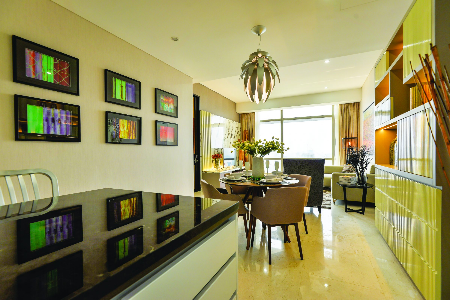Beyond just arranging dining and living room furniture sets near each other, there are a host of other considerations that one should look into when combining these two functionally separate areas.
 Interior design by: Kuzoj
Interior design by: Kuzoj
With space at a premium in urban homes, combining two of the areas that often take up the most space is a practical way of freeing up room for other functions. But things can get a little busy and cluttered when combining dining and living areas in small spaces such as a studio apartment or a home with an open floor plan. In light of the many ways that this merging can be achieved, we took a look at the most notable combined spaces we have seen over the years and extracted the base ingredients for your perusal here.
1. Grouped Arrangements
If you have the space to spare in your open plan home, the easiest way to combine the dining room with seating lounge is to position the respective furniture into two separate but adjacent groups - with an empty gap for a walkway between the two groups providing a means of access and to act as subtle demarcation.
 Interior design by: SQFT Space Design Management
Interior design by: SQFT Space Design Management
2. Narrow Spaces
For a comfortable dining experience, diners need between 90cm to 1.3m of space to be able to pull out a chair and take a seat, with around 60cm to 70cm of space between each seat for adequate elbow room. If space is limited, opt for a narrow rectangular table to discretely occupy the space on one side of the seating lounge.
 Interior design by: Pocket Square
Interior design by: Pocket Square
3. Informal Seating
At the most extreme end of the scale, one could also go beyond merging dining and living areas, by having seating and dining table occupy the same space. Replacing chairs on one side of a dining table with an upholstered bench creates a casual setting for meals and enables one to forgo having a sofa set - if the comfort and formality are not to be missed.
 Interior design by: The Roof
Interior design by: The Roof
4. Wall Features
To rein in the surplus empty space in your open plan layout, build up false wall projections and turn them into shelving or see-through niches to provide a means of visual separation as well as a functional fixture for additional storage.
 Interior design by: Beata Home and Office Furnishing
Interior design by: Beata Home and Office Furnishing
5. Decorative Ceilings
Even the thinnest of wall façades will take up some space, if only a negligible amount. To clearly demarcate your combined dining and seating lounge without occupying any of the valuable floor space, consider forming borders on the ceilings to visually indicate the extents of the functionally separate areas.
 Interior design by: Design Base
Interior design by: Design Base
6. Island Bars
Even without a dry kitchen adjacent to the seating lounge, it is possible to incorporate bar-height counters or kitchen islands - along with some stools or chairs of appropriate height, to provide a dining space in close proximity. Opting for countertop dining makes for a casual dining experience, and frees up additional space for other uses, such as a more spacious seating lounge.
 Interior design by: Pins Studio
Interior design by: Pins Studio
 Interior design by: Luna Solutions
Interior design by: Luna Solutions
7. Raised Platforms
With a small measure of additional space in an open floor plan, a slightly raised wooden platform would serve to elevate, highlight, and to keep the dining space visually distinct from any nearby seating.
 Interior design by: Pins Studio
Interior design by: Pins Studio
8. Decorative Archways
Building up a decorative archway between dining and seating furniture is another space-efficient way of define the combined areas, but best results are achieved in wide spaces so as not to make the open floor plan appear cramped.
 Interior design by: D'Concepto Design
Interior design by: D'Concepto Design
9. Dividing Drapery
In lieu of features such as arches, shelving, or see-through niches, an opaque or transparent curtain can be drawn shut to provide a temporary privacy screen during meals, and opened between meals to preserve the spaciousness of the open layout.
 Interior design by: Zids Design
Interior design by: Zids Design
10. Unifying Style
Whatever the means you have chosen to apply in visually indicating the separate functions of your combined dining and seating area, a harmoniously applied decorative style will serve to unify the distinct spaces. A unifying style does not necessarily entail a repeated palette, as a cohesive décor can still be achieved with complementary colour pairs applied as interchangeable base and accent colours.
 Interior design by: Nu Infinity
Interior design by: Nu Infinity







Leave your comment